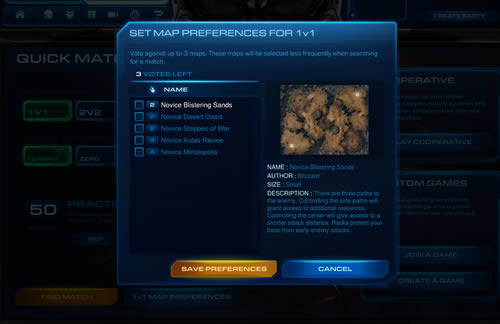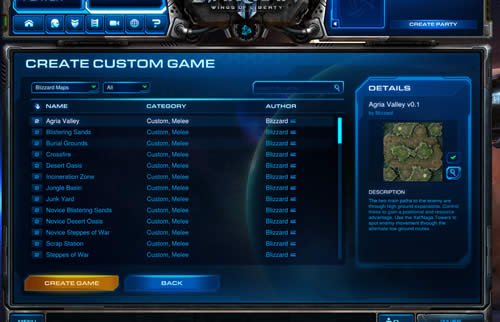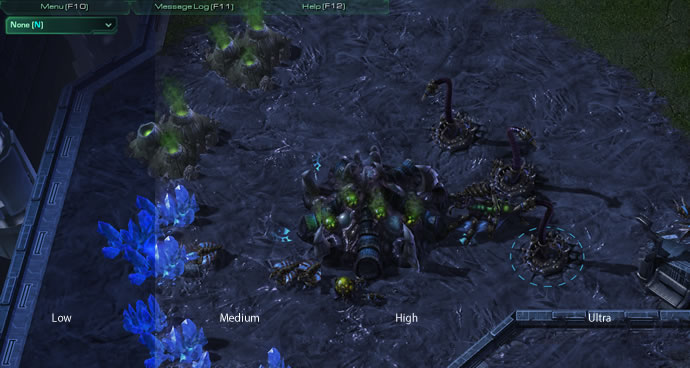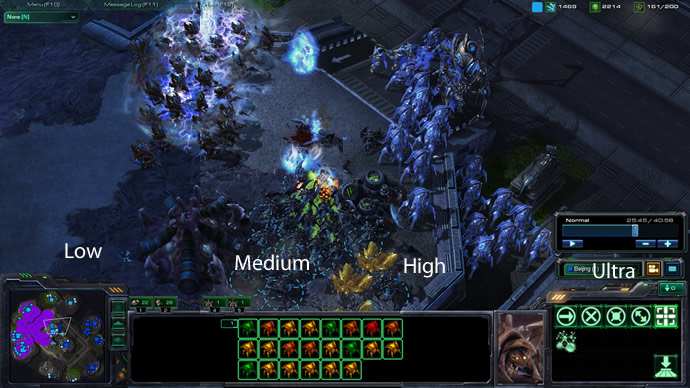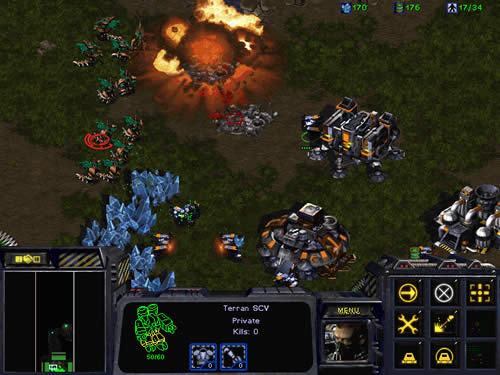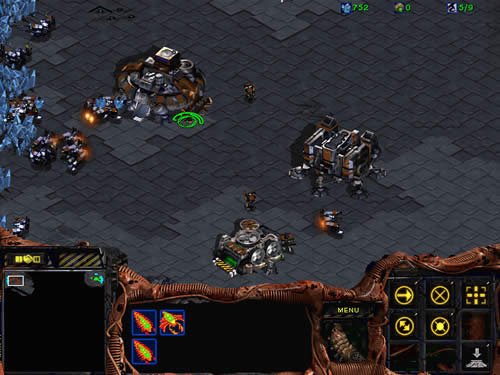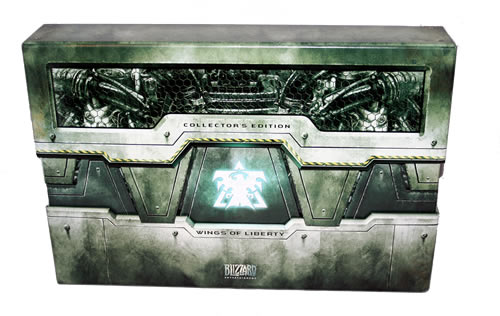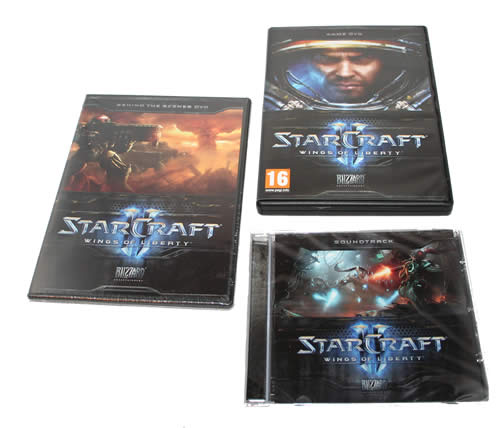StarCraft II: Wings of Liberty is the sequel to the enormously successful StarCraft from Blizzard Entertainment. Does Blizzard still know how to make an RTS game, or has World of Warcraft driven them from their roots?
INTRODUCTION
How does one measure the true success of a game? Sales figures from the first few months may be an indicator, but many games flare up, sell en masse due to hype, and then fade away in obscurity. The mark of a truly successful game, then, must be how long people keep playing it. In that regard, the original StarCraft must be one of the most successful games available. Released in 1998, the game has sold over 11 million copies (source: Wikipedia), and has a strong following amongst RTS-gamers who see it as one of the most balanced RTS-games ever created. It isn’t a coincidence that it is StarCraft that is used for online game sports in South Korea.
Like most gamers, we thought we would never see a sequel for this legendary game. After a decade long wait, here it is: StarCraft II: Wings of Liberty. We have seen a lot of great (and not so great) RTS games, like Supreme Commander expanding and evolving the RTS genre. The original StarCraft was an RTS classic. 12 years later, does Blizzard still have what it takes to bring StarCraft into 2010?

Before we examine the game, this reviewer would like to give readers some background about his experience with StarCraft. At the time the original came out, I played a lot of RTS games including StarCraft. I have never been a great online player, which meant I rarely ventured outside the confines of my local network, even then only to be slaughtered most of the time (I am a turtler and have problems coping with those who rush). It now has been many years since I played the original game, and nowadays I like to play more evolved RTS games like Supreme Commander 2 and Warhammer: Dawn of War 2.
This review is therefore aimed less at StarCraft fanatics who know the game inside and out, and more at those who have similarly moved on from StarCraft to other games.
The question then remains, will this game bring us back to our classic origins, or is 12 years too long to wait? Read on to find out.
STORY & GAMEPLAY
Discussing the storyline of a game is always a bit dangerous, as we risk spoiling the surprise for the gamers. We will keep this section brief, and concentrate on the gameplay. The game takes place after the original game (and the Brood War expansion). Users again play as the Terran soldier Captain Jim Raynor, this time fighting the Emperor Mengsk and the Dominion. After several setbacks, the character ends up on the ship Hyperion with a ragged crew which will serve as the main base during the game. The story itself is good, and players encounter their fair share of surprises on the way to the final missions.
The ship Hyperion also serves as an interactive hub between missions. Users can walk around different parts of the ship, choose mercenary missions, research new technologies and updates, and talk to the rest of the crew. This aspect of the game gives it the feel of an RPG like Mass Effect 2. The interactive parts are helpful, too, as talking to the crew members reveals new information and sometimes gives players the option of deciding how to proceed with a mission (whether to save the refugees on a planet from the Protoss, or help the Protoss kill them to stop a Zerg infection, for example). Blizzard even has put in a jukebox and an arcade game cabinet that both work.
Unfortunately, though the story itself is good, the voice acting falls short. The characters are somewhat clichéd and we found that we had a hard time really connecting with them.
Since Blizzard Entertainment helped to define the RTS genre, we all should know what to expect. The game is a nice mix of base building, micromanaging and tactical fighting. It does not revolutionize the genre, instead opting to simply evolve from the original StarCraft formula a bit. Here are a few of the minor changes Blizzard made:
- Players can now queue up orders to workers instead of tasking them one by one. This relieves players from having to constantly micromanage workers.
- Players can set rally points inside bunkers, transports, mineral deposits and vespene gas sources so that the units coming out directly move and start working.
- When grouping a large number of units players can cycle through units of the same type by using the Tab key. This allows users to access the units’ special abilities even when they are part of a larger group selection.
- Idle workers can quickly be accessed by pressing F1
Blizzard’s wish to stay true to the StarCraft name is understandable, but we cannot help but notice the distinct absence of certain features common to RTS games today. The lack of the zoom feature so players get a better view of the battlefield, and the exclusion of the troop formation feature leaves us wondering.
Despite these minor issues, the game simply is great fun. Though we are by no means experts, the game feels properly balanced, and does not leave players feeling cheated by the AI. The phrase “easy to learn, hard to master” is applies precisely.
The missions in the single player game do a nice job of introducing various units one by one. This works pretty well, although from time to time we felt that they have made it a bit easy as you know that the unit you just got access to is the one that you need to produce a lot of to be able to win. At the same time this is probably the idea as the single player campaign could be seen as a long training camp to prepare you for multiplayer.
It should be noted that Star Craft II: Wings of Liberty only lets players play the campaign from the view of the Terrans. Campaigns for the Zerg and Protoss will be released as DLC at a later date. When we first heard this it felt like Blizzard was getting greedy but after playing Star Craft II: Wings of Liberty we think that you also can see this as a way to make sure that each side gets a proper story and not just a third of a story.
One fun addition to Star Craft II: Wings of Liberty is that it contains achievements. Those of us owning a console are familiar with the concept of achievements and trophies. The idea is to reward people with small badges when they meet a requirement like finding a hidden artifact or killing 200 zergs without losing a unit. It speaks to the competitive nature of us gamers and it does make it even more fun to replay single player levels to “just get that last achievement”. The achievements also have been set up so that they reward people who replay the game on different difficulty settings.
MULTIPLAYER
One of the biggest changes made is that StarCraft II: Wings of Liberty no does not support LAN multiplayer. Instead it only supports the newly updated Battle.net service. An even worse aspect is that players are locked into a region, and cannot play against anyone in another region. Blizzard defends this, claiming they want ensure players get the best experience possible, by restricting them to playing against local players. We feel that this excuse defies logic, as we’ve played other RTS games like Supreme Commander 2 between US and Sweden based staff without any problems. Blizzard should at least allow players to play cross-region against Battle.net friends without saving the results.
Other than the regional restriction, Battle.net and StarCraft II: Wings of Liberty work very well together. For players hesitant to venture out on the internet, where they would most likely be slaughtered by StarCraft veterans, many skill building options exist. Players can access challenges which will help them learn more about controlling army movements and micro/macro-managing. These challenges are essentially expanded mini-tutorials, complete with achievements.
Players can also set up games against AI and simulate multiplayer battles. These are very fun, and we feel that the AI does a good job at a high difficulty setting.
When players are ready to play with or against real people, they can start in the Practice League, which consists of 50 matches against other new players. This league eliminates the chance of being pitted against StarCraft veterans. When players feel comfortable and ready to advance, Blizzard makes sure they do not have to start at the bottom of the barrel. Instead, players are gauged by performance in the first 5 games, and are placed in a ladder with gamers of approximately equal proficiency.
Another feature we loved in this game is the ability to spectate a game: there is no better way to learn than by watching the pros. Players can record their own games and watch a replay, but as far as we know, there is no way to watch replays of other people’s matches from within Battle.net. Luckily, sites like http://www.gamereplays.org and http://screplays.com/ let us easily watch replays.
The original StarCraft is still used in e-sports, and Blizzard built the multiplayer for StarCraft II: Wings of Liberty with that in mind. This is also most likely the reason there have been so few updates to the actual game play: why change something that so obviously works?
Players also get a guest pass that they can give to a friend. The pass allows the friend to play the game for 7 hours/game time) or 14 days after activation (whichever comes first). It is an excellent way to get friends to try the game and get them hooked.
AUDIO & VISUALS – PERFORMANCE
StarCraft II: Wings of Liberty looks great. The game is full of vivid colors and varied environments, and though it might not be as good looking at the closest magnification, players will never actually play at this zoom level. In fact, we feel the ability to zoom out even more or an increased resolution would be immensely helpful, as it would give us a broader look at the playing field. We can at least select different resolutions, since the original game was restricted to 640×480.
The game has a lot of different settings for the visuals, making it possible to fine-tune the graphics in great detail. Oddly enough, Blizzard has decided not to support anti-aliasing, so at the moment the only way to enable it is through the video card drivers. Both NVidia and AMD have drivers out that support this, although the AMD driver is only a “hotfix.” We have taken some screenshots from the game at different settings to show how the four pre-defined settings affect image quality. For each pre-defined setting (low, medium, high, and ultra) we set the texture quality to the same setting.
Click to open up a window where you can look at the images in full size.
Click to open up a window where you can look at the images in full size
The biggest jump in image quality comes when moving from “Low” to “Medium” setting. At the low setting, the game looks a lot like the original StarCraft. The visual differences between medium, high and ultra settings are not as obvious as between low and medium settings.
Since we reviewed the Collectors Edition of the game, we also got a USB-stick with the original game (read more about the CE edition on the next page), and being the curious technophiles that we are, we installed the original StarCraft to compare it to its successor. Here are some images from both the old game and the sequel. Remember that the original was stuck at 640×480 and was played on small CRTs, so it does look a lot worse on today’s big LCD screens.
StarCraft (1998)
Link to full sized image
StarCraft II: Wings of Liberty (2010)
Link to full sized image
StarCraft (1998)
Link to full sized image
StarCraft II: Wings of Liberty (2010)
Link to full sized image
Blizzard has stayed consistent with their style of graphics, only updating it for 2010.
We decided to test the performance with a variety of video cards. The system used for this test had the following components:
- AMD Phenom II X3 705e @ 2.5GHz
- ASUS M4A89TD PRO/USB3
- 4 GB DDR3
- Lite-On Optical drive
- Samsung 320 GB HDD, Samsung 1 TB HDD
We downloaded a replay from http://www.gamereplays.org/ and choose to record the framerate using Fraps for 3.5 minutes. This allowed us to capture framerates during both large battles and moments of very little activity.
It seems as though the game is quite CPU-dependent. This is further evidenced by the fact that the game suggests a default resolution of 1680×1050 even for the GTX480. From the charts above we see that there are very few performance differences between the HD5830/GTX460 and the faster GTX480/HD5870. We kept downgrading the card to see when it would become the limiting factor. We had to downgrade all the way to the HD5570 for it to limit instead of the CPU.
The game also supports all sorts of multi-channel sound, and it sounds great despite the mediocrity of the voice acting.
THE COLLECTOR’S EDITION
Collector’s Editions are usually a way for companies to squeeze more money out of us for some extra junk that is worthless. A lot of companies throw in a little plastic figurine and/or a “Making of DVD” and hope it is enough to convince people to pay more. The StarCraft II Collector’s Edition is an exception to this rule.
The box the game comes in is made out of cardboard but feels quite sturdy. In addition to the game box, the main package comes with the following items:
The Art of StarCraft II: Wings of Liberty, a 176-page book featuring artwork from the game
An exclusive 2GB USB flash drive replica of Jim Raynor’s dog tag, which comes preloaded with the original StarCraft and the StarCraft: Brood War® expansion set
It is quite cool to get the original game and add-on directly on the USB-stick. We tested it in Windows Vista and it worked great. The USB-stick/Dog tag lights up when inserted. Usually though, StarCraft fanatics have already bought the original game, and thus have no need to buy a Collector Edition.
A behind-the-scenes DVD containing over an hour of developer interviews, cinematics with director’s commentary, and more, The official StarCraft II: Wings of Liberty soundtrack CD, containing 14 epic tracks from the game along with exclusive bonus tracks
Does anyone actually watch these “Making of…” DVD’s or listen to the sound track?
StarCraft comic book issue #0, a prequel to the comic series
For people interested in these types of comics, this is actually a pretty cool item.
In addition to the physical items you also get: A World of Warcraft® mini Thor in-game pet that can be applied to all World of Warcraft characters on a single Battle.net account
Exclusive Battle.net downloadable content, including special portraits for your Battle.net profile, decals to customize your units in-game, and a visually unique version of the terran Thor unit.
Overall, this is a decent Collector’s Edition.
CONCLUSION
For those of us who were worried that Blizzard’s 12 year absence from the RTS scene would ruin the StarCraft name, we can put our worries to rest. StarCraft II: Wings of Liberty is a worthy successor to the original game that gamers everywhere loved so much. In fact, we would go as far as to say that anyone who liked the original will love the sequel. We were surprised at how easy it was to jump between the original and the sequel, and how alike they are. We do not know yet whether the sequel will equal the original in success, but the signs so far are encouraging.

For all its virtues, however, for those who never liked the original or the RTS genre, StarCraft II: Wings of Liberty is unlikely to change that contention. Blizzard’s hesitance to change the gameplay could be seen by some as cowardly, and many wish that they would revolutionize RTS (or even just bring it up to 2010 standards). They could have made sure that competitive online games were using a set of strict rules and settings, while allowing friendly games and the single player mode a bit more flexibility. Still, the game still is fun enough that we encourage skeptics to at least try it out. In fact, we hope Blizzard will start giving out more guest passes instead of demos, so more people can sample the full game.
In the end, even with the minor complaints, we think that StarCraft II: Wings of Liberty is a great game that has every chance to become as successful as its predecessor.
| OUR VERDICT: STAR CRAFT II: WINGS OF LIBERTY |
||||||||||||||||||
|
||||||||||||||||||
|
Summary: StarCraft II:Wings of Liberty is a worthy successor to StarCraft that has every chance to become as successful as the original. We are proud to bestow upon it our Golden Bear Award. |
 Bjorn3D.com Bjorn3d.com – Satisfying Your Daily Tech Cravings Since 1996
Bjorn3D.com Bjorn3d.com – Satisfying Your Daily Tech Cravings Since 1996



